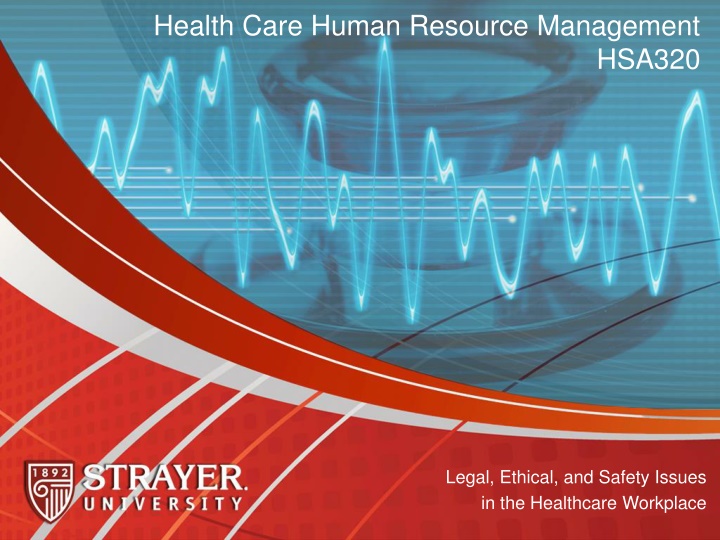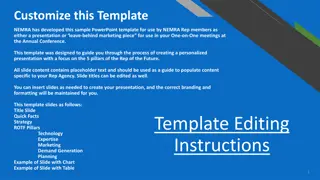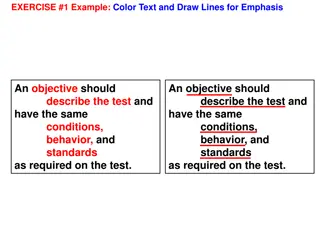
Legal, Ethical, and Safety Issues in Healthcare Workplace Management
Explore the legal, ethical, and safety aspects in healthcare workplace management including topics like basic concepts of law, tort reform, human resource-related legislation, ethics, and workplace bullying. Learn about laws, regulations, and key acts such as the Equal Pay Act of 1963, Civil Rights Act of 1964, Occupational Safety and Health Act of 1970, and more that impact healthcare workplaces.
Download Presentation

Please find below an Image/Link to download the presentation.
The content on the website is provided AS IS for your information and personal use only. It may not be sold, licensed, or shared on other websites without obtaining consent from the author. If you encounter any issues during the download, it is possible that the publisher has removed the file from their server.
You are allowed to download the files provided on this website for personal or commercial use, subject to the condition that they are used lawfully. All files are the property of their respective owners.
The content on the website is provided AS IS for your information and personal use only. It may not be sold, licensed, or shared on other websites without obtaining consent from the author.
E N D
Presentation Transcript
Health Care Human Resource Management HSA320 Legal, Ethical, and Safety Issues in the Healthcare Workplace
Topics Basic Concepts of Law in the Healthcare Workplace Tort Reform Human Resource-Related Legislation Basic Concepts of Ethics in the Healthcare Workplace Decision Model for Healthcare Dilemmas Code of Ethics Doctor Patient Relationship Other Healthcare Code of Ethics Developing a Code of Ethics Ethics and Research Workplace Bullying
Basic Concepts of Law in the Healthcare Workplace Law Common Law Statutes Rules and Regulations Criminal Law Civil Law Torts Negligence Intentional Torts Assault and Battery Invasion of Privacy Medical Malpractice
Tort Reform Defensive Medicine Monetary Cap Voluntary Hospitals Informed Consent Standard Care
Table 2 Equal Pay Act of 1963: All employers must provide equal pay to both genders that have the same position with equal responsibilities and skills. Enforced by the U.S. Department of Labor. Civil Rights Act of 1964, Title VII: Landmark legislation. Prohibits discrimination of protected classes based on gender, race, color, religion, and national origin. Enforced by the EEOC. Applies to employers with 15 or more employees. Age Discrimination in Employment Act of 1967 (ADEA): Protects employees and job applicants 40 years or older from discrimination in hiring, firing, promotion, layoffs, training, benefits, and assignments. Enforced by EEOC. Applies to employers with 20 or more employees. Occupational Safety and Health Act of 1970: This act requires employers to provide a safe and healthy work environment. Guidelines for working with hazardous chemicals and for working ergonomically. Enforced by the Occupational Safety and Health Administration. Rehabilitation Act of 1973: Employers with 50 or more employees and with federal funding of $50,000 must submit an affirmative action plan. Amended to ensure that healthcare facilities are accessible for the disabled. Enforced by the Office of Federal Contract Compliance Programs.
Human Resources-Related Legislation, contd. Table 2 (Continued) Employee Retirement Income Security Act of 1974 (ERISA): Regulates pensions and benefit plan for employees. Forbids employers from firing employees so the employers do not have to pay the employee s medical coverage. Give employees the right to sue for breaches of any fiduciary duty. Enforced by the U.S. Department of Labor. Pregnancy Discrimination Act of 1978. Protects female employees who are pregnant against discrimination. Applied to employers with 15 or more employees. Enforced by the EEOC. Consolidated Omnibus Budget Reconciliation Act of 1986: (COBRA): Passed to ensure that if an individual changes jobs, he or she can still obtain health insurance. Enforced by the U.S. Department of Labor. Worker Adjustment and Retraining Notification Act of 1989: Employers with 100 employees or more must give their employees 60 days notice of layoffs and closings. U.S. Department of Labor has no enforcement role but can assist with job placement.
Human Resources-Related Legislation, contd. Table 2 (Continued) Americans with Disabilities Act of 1990 (ADA): Protects the disabled from employment discrimination. Encourages businesses to provide reasonable accommodation in the workplace for qualified individuals that have disabilities but are able to perform a job. Applies to employers with 15 or more employees. Enforced by the EEOC. Its 2008 amendments expanded the concept of disabilities. Older Workers Benefit Protection Act of 1990 (OWBA): Amended the ADEA. Benefits must be provided to both younger and older workers. Gives time to accept early retirement options and allows employees to change their mind if they want to litigate against their company. Enforced by EEOC. Civil Rights Act of 1991: Amendment to 1964 Act. Enables individuals to receive monetary damages up to $300,000 because of intentional discrimination. Enforced by the EEOC. Applies to employers with 15 or more employees. This Act also established the Glass Ceiling Commission that examined the lack of protected classes in senior management positions.
Human Resources-Related Legislation, contd. Table 2 (Continued) Family Medical Leave Act of 1993 (FMLA): Requires employers with 50 or more employees within a 75 mile radius who work more than 25 hours per week and who have been employed more than 1 year to provide up to 12 work weeks of unpaid leave to an employee during any 12- month period so the employee may provide care for a family member or obtain care for himself or herself. Enforced by the U.S. Department of Labor. Uniformed Services Employment and Reemployment Right Act of 1994 (USERRA): Workers are entitled to return to their job after military service. Returning employees are not penalized from raises or promotions because they were in the military. The U.S. Department of Labor s (DOL) Veterans Employment and Training Service (VETS) enforces USERRA. Health Insurance Portability and Accountability Act of 1996: (HIPAA): Increased restrictions on patient information confidentiality by creating a standard for patient information sharing. Enforced by U.S. Health and Human Services.
Human Resources-Related Legislation, contd. Table 2 (Continued) Pension Protection Act of 2006: Amendment to Civil Rights Act of 1991. Landmark legislation that strengthens employer funding requirements for employee pension plans and creates a stronger pension insurance systems. Enforced by the U.S. Department of Labor. National Defense Authorization Act of 2008: Expanded the FMLA to include families of military service members, which means that an employee may take up to 12 weeks of leave if a child, spouse or parent has been called to active duty in the armed forces. Enforced by the U.S. Department of Labor. Genetic Information Non- discrimination Act of 2008: Prohibits U.S. insurance companies and employers from discriminating based on genetic test results. Enforced by the EEOC.
Human Resources-Related Legislation, contd. Table 2 (Continued) Lilly Ledbetter Fair Pay Act of 2009: An amendment to Title VII of the Civil Rights Act of 1964 that also applies to claims under the Age Discrimination in Employment Act of 1967 and ADA and provides protection for unlawful employment practices related to compensation discrimination. Enforced by the EEOC. Patient Protection and Affordable Care Act of 2010 (PPACA): Controversial legislation that requires individuals to purchase health insurance by 2014. Contested by several states for its constitutionality, provisions of the Act will be reviewed by the Supreme Court in 2012.
PROPERTIES On passing, 'Finish' button: On failing, 'Finish' button: Allow user to leave quiz: User may view slides after quiz: User may attempt quiz: Goes to Next Slide Goes to Next Slide At any time At any time Unlimited times
Basic Concepts of Ethics in the Healthcare Workplace Ethical Standards Healthcare Ethical Dilemma Autonomy Beneficence No Malfeasance Justice Dignity
Decision Model for Healthcare Dilemmas PLUS Decision-Making Model Step 1- Define the Problem Step 2- Identify the Alternatives to the Problem Step 3- Evaluate the Identified Alternatives Step 4- Make the Decision Step 5- Implement the Decision Step 6- Evaluate the Decision
Codes of Ethics Code of Ethics Doctor-Patient Relationship The American Medical Association American College of Physicians and Harvard Pilgrim Health Care Ethics Program Other Healthcare Codes of Ethics American Nurses Association Healthcare Executives Code
Developing a Code of Ethics When Developing Code of Ethics, it must be: Written clearly Specifically developed Current Follow a specific outline
Ethics and Research Institutional Review Boards (IRBs) Research Informed Consent Common rule
Workplace Bullying in Health Care Workplace Bullying Impact of Workplace Bullying Legal Implications of Workplace Bullying
Recommendations to Eliminate Workplace Bullying Adopt a Policy of Zero Tolerance Create an organizational culture Reward Behaviors Develop and Educational Program
PROPERTIES On passing, 'Finish' button: On failing, 'Finish' button: Allow user to leave quiz: User may view slides after quiz: User may attempt quiz: Goes to Next Slide Goes to Next Slide At any time At any time Unlimited times
Summary Basic Concepts of Law in the Healthcare Workplace Tort Reform Human Resource-Related Legislation Role of Ethics and the Five Basic Values Decision Model for Healthcare Dilemmas Code of Ethics and the Doctor-Patient Relationship How to Develop a Code of Ethics Ethics and Research Workplace Bullying






















